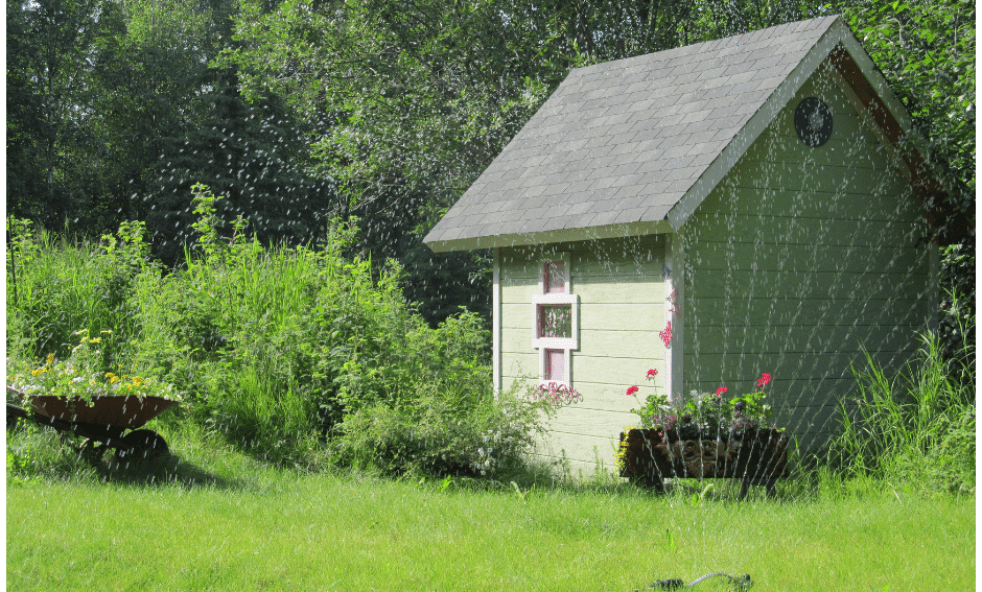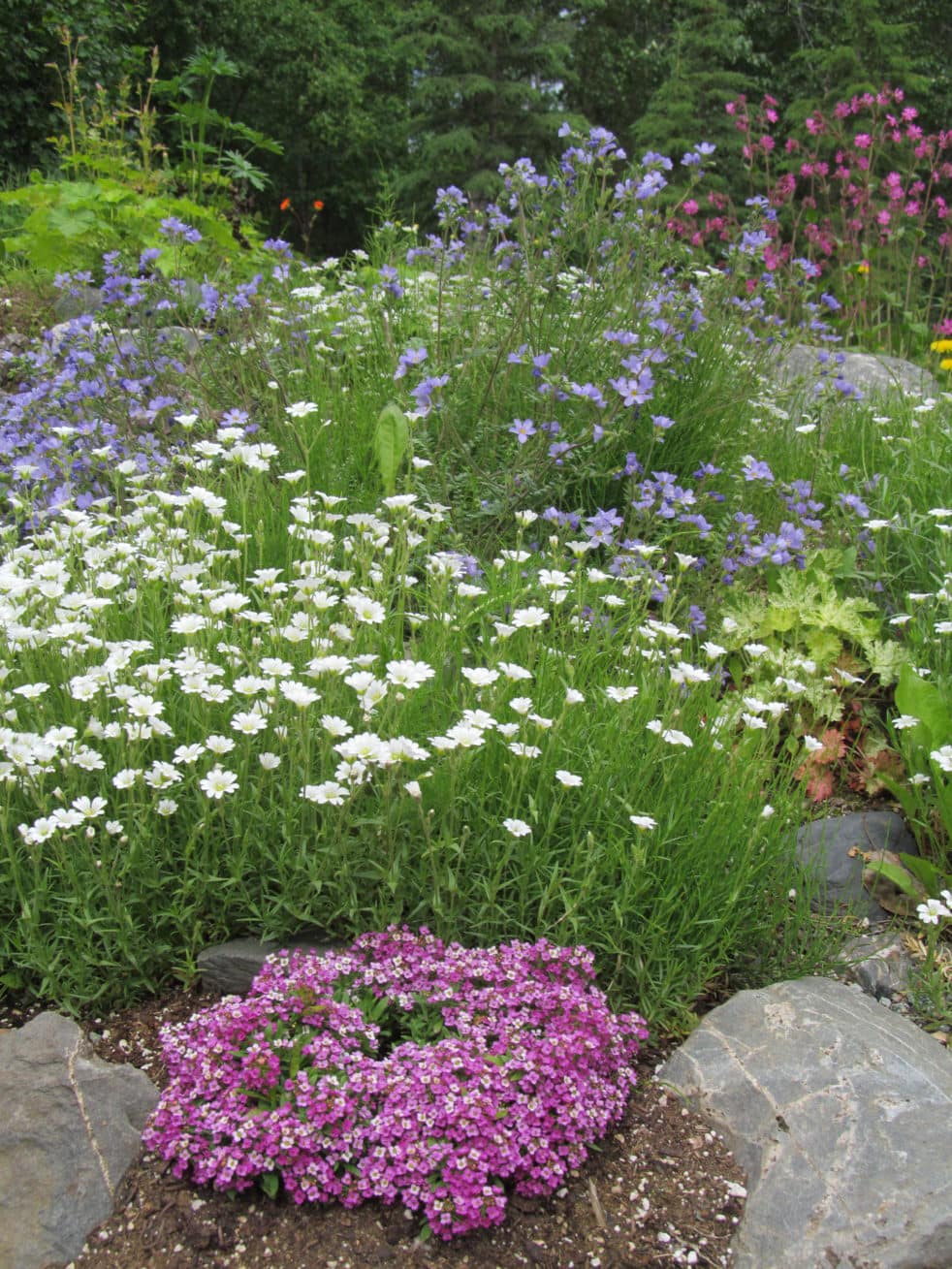
Introduction: If you have tried to keep weeds down with a weed block mat in the past, you may have discovered its shortcomings. When the cheap, plastic stuff from the box stores fails, you may have tried the more expensive commercial-grade landscape fabric. It looks great for a while. Then, after a few years, you find that you’re back to the same issues.
This article will shed some insight into why weed blocks fail, and introduce new, organic methods that not only reduce weeds, but are healthier for your soil and thus your plants.
No question about it. A nice, neat border shows off your flowers and is part of the artistry of your landscape as well! After all, the purpose of a border is not just to hold the dirt in but to give definition to the garden bed itself. Whether you use rocks, logs, bricks or just simple plastic edging, the border itself conveys your style. At the same time, it’s a lot of work to keep weeds down so it looks its best.
Here’s an easy, low cost (and money saving) method to keep weeds down for a beautiful border. Money-saving because you’re not spending for harmful chemicals or the commercial weed mat. You might call it “organic” weed control. It’s good for your plants and good for the environment.
What is it? MULCH! Yup, it’s no big secret. Only the ‘mulch’ I’m referring to is in the form of cardboard.
If you think you’ve seen or heard of this before…please…read on for new insights into the use of weed mats. It’s new to me, too!
Layering is the ‘key’ to keep weeds down
Make it a Garden is all about “simple paths to inviting places” and nothing is more simple than re-cycling your cardboard for weed suppression. Especially if you live in a rural area. In my neck of the woods, there’s no trash service, so I recycle all my cardboard and paper. There’s no charge for dropping it off at the recycle center in town. Since paper and cardboard is a substantial part of my trash, re-using it means less accumulation which equals fewer trips to the local transfer station along with the rest of my garbage. So, I pay less as well!
Perhaps you’ve tried the cardboard approach before. I have too. Actually, I had used newspaper. A few thin sheets. The weeds always grew back, didn’t they? It’s not perfect. But, what I’m re-discovering now, is the effectiveness of layering the cardboard in order to keep weeds down. I’m giving it another try and hope you will, too!

This summer, I decided to put in a little garden bed near the front porch. Something I’d been wanting to do since we built the place. Being in the mountains, I prefer to use rocks in my border for a more rustic look that’s in harmony with the scenery. Typically, I’d start by laying down a commercial grade weed mat, (more on that coming up), but I had none left after using what I had on hand for other projects.
With perennials desperately needing to get into the ground, I chose to go back to an old-fashioned alternative to keep weeds down…cardboard mulch. The good thing about paper products is that as paper breaks down, it delivers important nutrients to the soil and thus to your plants. The weight and density of the cardboard suffocates vegetation and prevents it from emerging.

Create a cardboard mat to keep weeds down
Making and installing a cardboard mat is easy and doesn’t require much physical labor. Or even an extra hand to help. This is as DIY as it gets, with emphasis on the ‘Y’!
Lay all your cardboard trash out on the ground in a single layer. Don’t worry about cutting up food boxes. Use the hose to soak everything down. Spray it and let the water absorb a bit, then hose the pile down again until the cardboard is thoroughly saturated and limp. The glue that holds the food boxes together literally flops apart and you have a nice, wide pliable strip that’s easy to position.
Again, the key is layering. After you’ve put down the first layer of cardboard, lay another saturated row right over the top. If you’re working on a hot day and the cardboard starts to dry, just wet it down some more. Keep layering until you’ve got a nice thick layer of cardboard, three or four layers. You can even use woodchips and grass clippings between the layers.
After you’ve established a nice thick layer, you’re ready to add your border/edging material…rocks, logs, bricks etc.

Granted, it’s not maintenance free and over time some weeds will appear. Remember that the ones that emerge have probably started from seed. Decomposing cardboard mulch creates a medium for weed seeds to germinate and grow. You’ll still have to do some “hand mitigation”, but there will be far fewer weeds and they will be easier to pull. And, when that starts to happen, you can also add another layer or two of cardboard.
Sheet mulching
If you want to start your garden bed on a less weed-prone platform, here’s an excellent link about sheet mulching from Family Food Garden: “lasagna gardening” (scroll down a bit in this post).
May I encourage you to conduct a little experiment? If you have used a plastic weed block, or even a commercial grade fabric, try the cardboard method for a couple of seasons. Even if it’s just in one small area or one garden bed so that you can compare.

What, no landscape fabric?
Here’s a brief review of the controversy over landscape fabric used to keep weeds down. There are a few reasons why you might not wish to use it.
Does this photo look familiar? These are photos of my own garden where I used a commercial-grade fibrous mat just three years ago. I laid gravel over the top. The primary weeds are dandelion, horsetail, and yarrow…all pretty tough.



Commercial weed barriers do not snug the ground (doesn’t seem to matter what medium you put on top) and harbor multiple air pockets that allow weeds to grow. Tough weeds (like the wild yarrow above), are able to poke right up through. The fabric always seems to get punctures which gives way to more weeds. After a while, it just looks messy.
Why weed block does not keep weeds down
Most surprising to me was the discovery that most weeds do not come from the bottom up, but from the top down! The wind blows dust into your top cover of bark or gravel. Leaves drop from trees. It’s not too long before decomposition creates a fresh new layer of top soil for seeds to germinate on top of the landscape fabric.
Landscaper Jim Putnam has this short 6 minute video on the subject.
As weeds grow, tiny little roots shoot their way through the cloth and anchor in the earth below. You end up making more work for yourself because it’s so much harder to pull weeds because the roots are caught underneath the cloth. Doing so creates larger tears in the cloth and dishevels everything on top that must be put back into order afterwards. Less effort? I don’t think so!
Weed mat is also problematic for earthworms and other insects that are beneficial to your soil.
Giving cardboard another try
Hence, I have gone back to the old-fashioned method of using cardboard, only now, I’m using thicker layers to mulch around my beds and borders. In the picture of my forger-me-nots below, I’ve pulled up the worn commercial mat and replaced it with several layers of cardboard. Then I recovered it with gravel.

DON’T FORGET YOUR FREEBIE! Sign up below to receive “10 Artistic Ways to Make Your Yard or Garden Beautiful”. Come be part of the Make it a Garden Community of art and garden lovers!
Another discovery is that planting your annuals and perennials closer together crowds out the weeds, rather than the other way around. We’re finding that a lot of these plants and flowers can be planted much closer together than what’s indicated on the tag from the nursery.
A lot of people only have a few plants surrounded by a sea of bark mulch. There’s a lot of open area between them. We’re now learning that planting more flowers, grasses, and shrubs closer together helps to curb weeds from gaining a foothold in your landscaping. Besides, you’ll have a fuller, more lush look, too!
Conclusion
No matter what method you use, weeds will be a fact of life. There is no permanent solution. The best weed management is to pull them by hand. However, if you do this a little at a time, and when the weeds are small, you’ll manage to stay ahead of the game.
By creating a weed barrier using a natural, biodegradable mulch, it will make the chore a bit easier. Sheet-layering paper and cardboard does a pretty good job of keeping weeds from emerging. And that keeps your borders looking neat and tidy and the flowers looking beautiful all summer long!
Did you find this article helpful? Then by all means, share it on Facebook and tell your friends about Make it a Garden. I’d love to hear your feedback regarding weed control fabric or use of organic mulch. Leave a comment below!
Related posts you might be interested in:
Keep Moose From Eating Your Trees & Shrubs
A Cheap & Effective Way to Kill Aphids


This is a most excellent use of cardboard. I recycle all of my paper and cardboard but am now going to save some to test as you recommend. Thanks, Kris!
Thanks for stopping by! Yes, I had used paper before, but not the layering process. I half-suspect it’s going to outperform the commercial weed block. Please let me know what your results are.